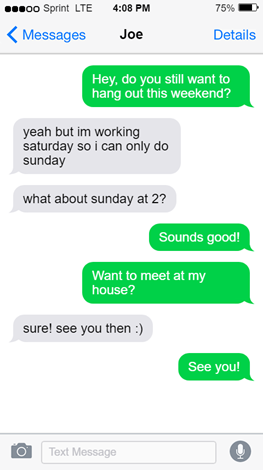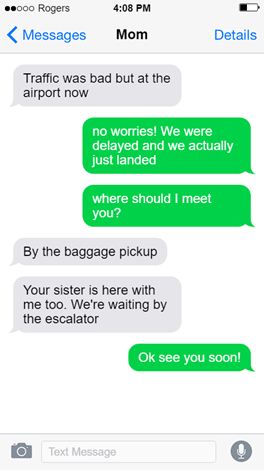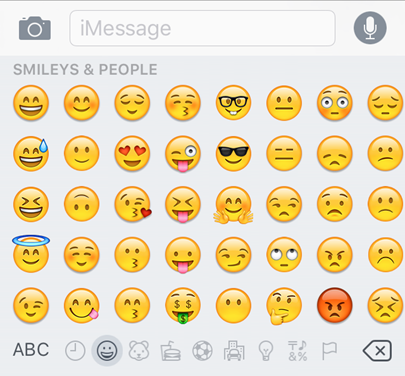Appearance
Unit 5 | Communication
Texting
Texting involves sending short messages sent over a cellular network between phones. It is not necessary to know the technical explanation of what a cellular network is. The main idea is that cellular networks are separate from the internet, and they are used to deliver phone calls and text messages.
Compared to email, texting is more informal, and the messages are usually much shorter. It is often used for casual types of conversations such as those between family and friends. Unlike email, texts don’t usually have a formal structure. You don’t even need to use proper punctuation or capitalization! Here are some examples of texting conversations:


Emojis
Emojis are small pictures that you can include in texts to convey emotion and tone. They are used in texting, on social media, and in many other contexts. Emojis are part of the keyboard options of most phones, so you can type them in addition to letters, numbers, and symbols.

The emojis in the image above are all faces with different emotions. There are also all sorts of other emojis, such as animals, food, household objects, and more!
Abbreviations
Texting can be slower than typing on a computer. People often use abbreviations since they’re faster than typing an entire phrase. Here are some abbreviations you might run into:
- Lol = Laugh out loud
- Omg = Oh my god
- Lmao = Laughing my a** off
- Btw = By the way
- Idk = I don’t know
- Ily = I love you
- Brb = Be right back
- Jk = Just kidding
- Smh = Shaking my head
- Tbh = To be honest
- Wtf = What the f***
- Gn = Good night
- Ty = Thank you
- Np = No problem
- Nvm = Never mind
- Ikr = I know, right?
If someone uses an abbreviation that you don’t know, you can search online to find out what it means. For instance, you could search “what does lol mean” and the first result explains that it stands for “laugh out loud.”
Phone numbers
Just like emails are addressed to email addresses, texts are addressed to phone numbers. When you sign up for a cell phone plan, you get a given a phone number with 10 digits, such as 123-456-7890. This phone number is how people can reach you, both by phone call and by text.
Contacts
A cell phone can remember people's phone numbers and names for you! There is a contacts app on any cell phone for this purpose. When adding a contact, you enter the person's name, phone number(s), and optionally other information like their birthday. Then, when you want to text or call them, you can look for their name instead of having to type in their number.
